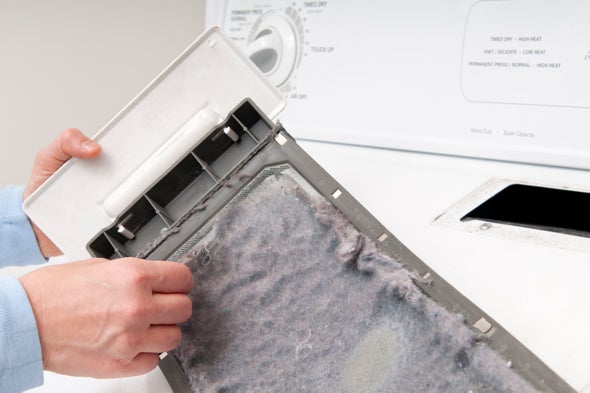(单词翻译:单击)
听力文本
This is Scientific American 60-second Science, I'm Eilene Augenbraun.
Plastic waste breaks down into ever smaller pieces, becoming tiny enough to waft in the air and flow in the water. A study published in June found that a person, on average, inhales or swallows at least 74,000 microscopic particles of plastic each year. And there are multitudes of miniscule plastic beads and fibers in the environment.
So what's the most common type of microplastic? Recent research finds that, in freshwater at least, it's tiny pieces of artificial fibers—from laundry lint.
"We were interested in the microbeads, and we found them, but we found microfibers much more prominently. So 60 percent of the microplastics that we obtained were actually these microfibers."
Sherri Mason is a chemist specializing in plastic pollution in freshwater systems at Penn State Behrend.
"I was surprised, although, like, you kind of go, 'Oh, I really shouldn't have been.' Because we all clean out our lint filters on our dryers. You know, we should be like, 'Oh, of course if it's coming off in the dryer, that whole process is starting in the washer.'"

Synthetic textiles shed nonbiodegradable fibers, which enter wastewater—and travel beyond. Mason's report is in the publication American Scientist.
"There are microplastics in the air, and as you have, you know, precipitation events, it—they come raining down. Or as basically air comes into contact with water, these microplastics are going to end up in the water that way." Even in the most isolated corners of the world.
Mason notes that natural materials also shed fibers in the wash, but microbes know how to digest them. Not so for microplastic fibers. They may take centuries to degrade, so they accumulate.
"And fibers, microfibers, are quickly becoming kind of the most prominent, and we find them everywhere. And I think now people are, like, 'Okay, we really need to be looking at these fibers.'"
For Scientific American — 60-Second Science. I'm Eilene Augenbraun.
参考译文
这里是科学美国人——60秒科学系列,我是艾琳·奥根布劳恩。
塑料垃圾会分解成更小的碎片,小到可以在空气中漂浮,也可以在水中漂流。今年6月发表的一项研究发现,一个人每年平均吸入或吞咽至少7.4万颗塑料微粒。环境中存在大量极小的塑料珠和塑料纤维。
那哪种微塑料最常见?最近的研究发现,至少在淡水中,最常见的是人造纤维的微小碎片——来自衣服上的绒毛。
“我们以前对塑料微珠感兴趣,我们找到了它们,但我们发现微纤维更为突出。我们获得的60%的微塑料其实是这些微纤维。”
宾夕法尼亚州立大学贝伦德分校专门研究淡水系统塑料污染的化学家谢莉·梅森说到。
“我很惊讶,不过你可能会说,‘哦,我真的不应该这样。’因为我们都会清理烘干机上的绒毛过滤器。我们应该说,‘哦,当然,如果微纤维掉在烘干机里,那整个过程就是从洗衣机里开始的。’”
合成纤维脱落下不可生物降解的纤维,这些纤维进入废水中,然后漂向别处。梅森的报告发表在刊物《美国科学家》上。
“空气中存在微塑料,当发生降水事件时,它们会随雨水落下。或者当空气与水接触时,这些微塑料最终会以这种方式进入水中。”就连世界上最偏远的角落都有微塑料。
梅森指出,天然材料在洗涤过程中也会脱落纤维,但微生物知道如何消化它们。但微塑料纤维却不会被消化。它们可能需要数百年才能降解,因此它们会不断积累。
“纤维、微纤维正迅速成为最突出的东西,而且我们到处都能找到它们。我认为现在人们会说,‘好吧,我们真的需要好好研究一下这些纤维了。’”
谢谢大家收听科学美国人——60秒科学。我是艾琳·奥根布劳恩。
译文为可可英语翻译,未经授权请勿转载!
重点讲解
重点讲解:
1. break down (使)(物质)分解;
Over time, the protein in the eggshell breaks down into its constituent amino acids.
时间久了,蛋壳中的蛋白质就会分解为其构成成分氨基酸。
2. at least 至少,起码;
Success was assured and, at least to start with, the system operated smoothly.
成功有保证了,至少该系统一开始运行得挺顺利。
3. clean out 彻底清理(橱柜、房间、容器等);把…打扫干净;
Mr. Wall asked if I would help him clean out the bins.
沃尔先生问我能不能帮他把各个箱子彻底清理一遍。
4. come into contact with 接触;遇见;
Common sense tells us that most fuels can burn only when they come into contact with air.
常识告诉我们,大多数燃料只有接触空气时才能燃烧。


